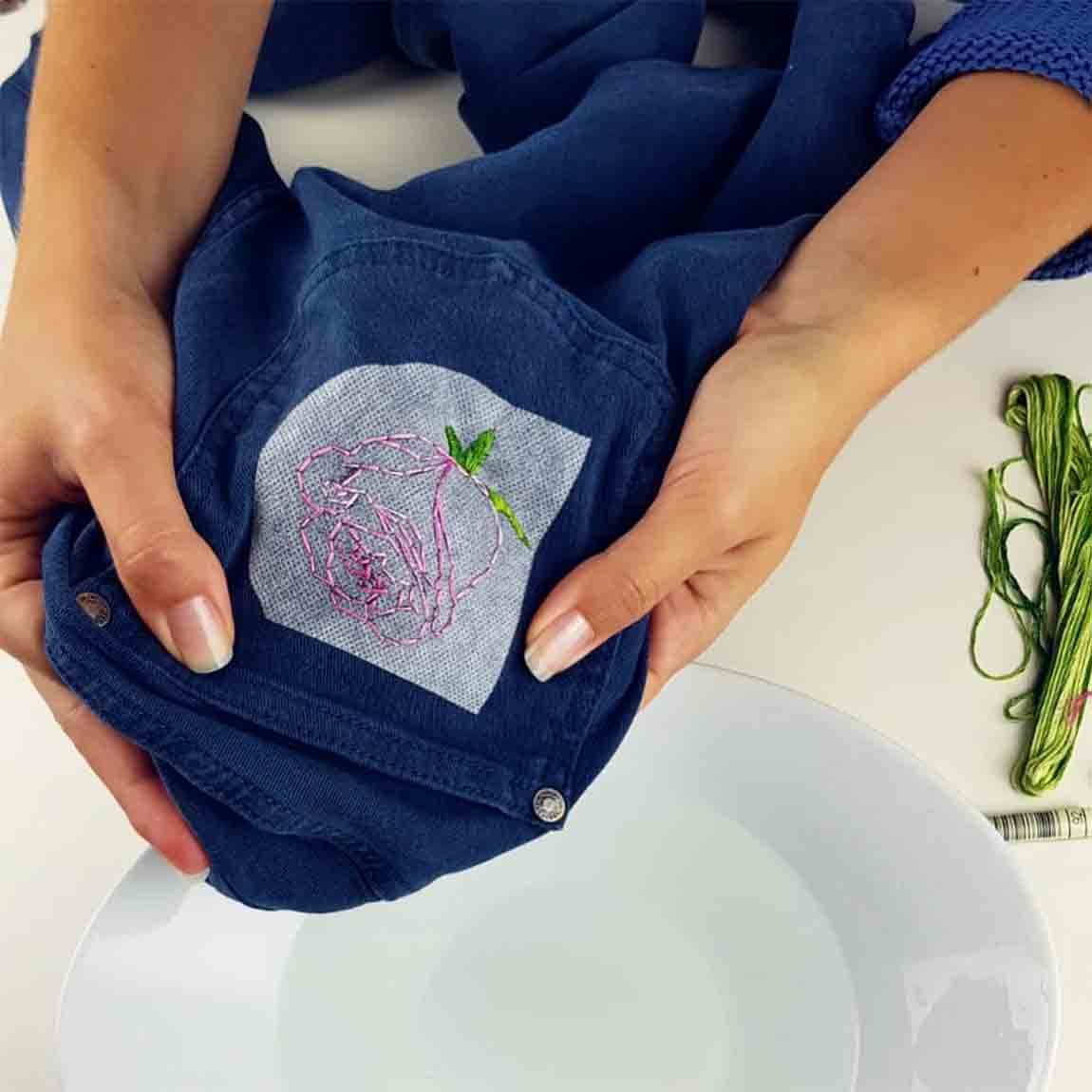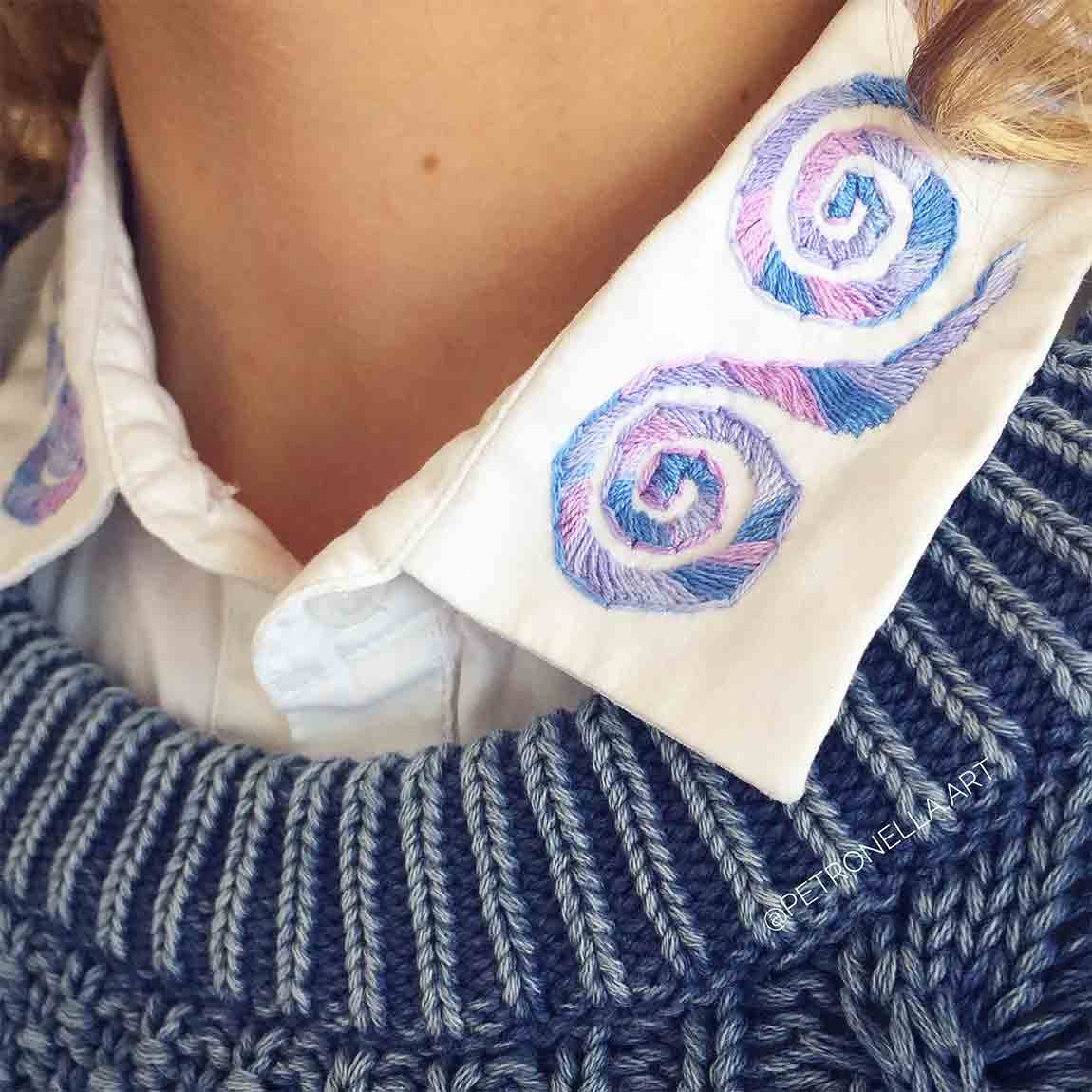All You Need to Know about Embroidery on Clothes
Do you also dream to join the upcycle movement and have home embroidered clothes, but have no idea of how to do embroidery by hand?
If you have never done embroidery before it can be difficult to know how to do without the risk of ruining the clothes.
So, what type of clothing can you embroider on?
Technically you can embroider on anything!
It’s very common to embroider on jeans, T-shirt, shirts, knitwear and dresses.
The process of how to embroider on the different clothes will depend on the quality and characteristics of the fabric.
Is it thin, thick, stretchy or no stretch?
This will all have a big impact on both the process and techniques to use.
But before you start, you need to have some materials.
Here is a list of things you need to embroider on clothes:
Choose your clothes that you want to embroider. And identify whether it’s stretchy or not.
Get good quality embroider floss such as DMC or Anchor threads. You need good quality threads that don’t color off or shrink in the washing when you want to embroider directly onto the clothes
Get a long and thin needle. You want to avoid to create to big holes in the garment with a top thick needle. And the length will help you to easier make resistant double sided stitches.
Get a frixion pen, solvy paper, water soluble pen or iron on pen to transfer/draw your embroidery design onto the clothes.
Looking for more in depth Tutorials?
Then you’ll love our online course on how to personalise your clothes with modern hand embroidery!
Can you embroider directly onto clothing?
Yes you can definitely embroider directly onto clothing.
To clarify some important things about the process, I have created a bullet list below:
What to think about when you want to embroider directly onto your clothes:
If your clothes are stretchy you should avoid to use an embroidery hoop. You may even want to consider to use a stabilizing backing (though personal preference)
If the fabric is stretchy you have to be gentle on your hand as you stitch to avoid creating bubbles
Be sure to secure your threads with tight knots so that you can wash the piece in the machine.
Never tumble dry embroidered clothes.
Wash embroidered clothes in no more than 40 degrees Celsius to avoid coloring off from the embroider floss.
How to transfer embroidery designs to clothes?
There are a few different ways to transfer an embroidery design to clothes:
Solvy paper is highly recommended when you embroider on a stretchy tshirt. The reason is that the solvy paper (or magic paper) serves as a temporary stabiliser while stitching. It later dissolved in water, which leaves the tshirt smooth and comfortable.
Solvy paper is also very useful when you want to make an embroidery design in an area where you can’t transfer though the fabric. In other words, you can’t see through the fabric because it’s either a) too thick or b) Where you want to stitch is inconveniently located (e.g a back pocket). The solvy paper transfers on top of the fabric so you don’t have to think about being able to see through and trace along.
A water soluble pen can be perfect to use for transfer when you can see through the fabric. For example on a thin cotton shirt that is non stretch. You place your pattern underneath the area where you want to stitch and trace the lines. Tracing easily washes off in water.
The iron on pen is another way to transfer a detailed design on top of the clothing. The most important thing to keep in mind is just that the iron on pen doesn’t wash off. So you have to trace your pattern carefully to not make any mistakes, whereafter you turn the pattern over with the tracing facing down on your clothes and then iron it over.
How do you draw hand embroidery designs on clothes?
You can use a water soluble pen or heating pen to draw on your clothes.
These techniques will allow you to easily get unwanted tracing off.
As opposed to the listed options for tracing designs onto clothing above, drawing directly gives to the most freedom.
Personally, this is the process that I find to be the most fun.
I even encourage you to try and embroider directly onto the clothes without any drawn design at all.
It’s a perfect practise and expression of your creativity.
For example, assemble all your left over floss from previous projects and use those as your base.
This is what I did for one of my knitted dresses that I wasn’t using anymore.
I used to wear it all the time, but just felt it looked too boring now.
Thanks to floss of my favorite colors it now looks great again.
How to embroider on jeans?
This depends on whether your jeans are stretchy or not.
In addition where on the jeans you want to embroider.
Let’s assume that you want to embroider on a stretchy pair of jeans.
Then the process is very similar to embroidery in a tshirt.
This means that you need to be careful when you pull your stitches so that you don’t pull too hard.
Because otherwise you will create bubbles in the fabric.
And the stitches will make the embroidery too small and tight for you to smoothly put the jeans back on.
If your jeans are non stretch the process is immediately easier.
You can for example use a hoop without any risks, which helps to stabilize the fabric and thereby your stitches.
If you embroider on a pocket be aware of not closing the pocket.
A tip is to put a piece of paper or similar in the pocket to serve as a blocker.
We have a full module on how to embroider on jeans in our master class “Personalise your clothes with modern hand embroidery”.
Do I need backing or stabilizer for embroidery on clothes?
Backing is a common question and the answer is: it depends.
First it depends on your preference when you wear the clothes.
Because some backing stays after completion, which then can have an impact on how it feels to wear your clothes afterwards.
Personally I never use backing when I embroider on clothes.
I don’t think it’s comfortable. Furthermore I find that I lose a bit touch with the quality and characteristics of the fabric.
It’s a great practise to really feel and understand the movements of the fabric you work with.
If it’s a stretchy fabric, you get to practice how to be careful and light on your hand and to work with it to your benefit.
With that said, a backing can naturally be super helpful if you’re not used to embroider on clothes.
It gives a solid support, which reduces the risk of mistakes.
To use a backing especially reduces the risk of pulling the stitches too hard and thereby creating bubbles in the fabric.
What is the easiest clothing to embroider for a beginner?
The easiest is to start with a non stretch shirt.
Because you are able to use an embroidery hoop as stabiliser and support,
Furthermore, the process of stitching is easier, which allows you to be more relaxed.
Can I embroider with colors on a white shirt?
You can definitely embroider with strong colors on a white tshirt or shirt.
As long as you make sure that you use quality threads that don’t color off.
A trick to be sure that your threads won’t color off is to boil them first.
When you boil your threads you take off the risk that the threads shrink or color off in the washing machine later on.
Because if there’s some leftover color or risk of shrinkage, you will immediately see it after boiling.
The same principle applies to your clothes.
Not that you would boil your clothes.
But it’s a good idea to wash your clothes (or they’re new) before you decide to embroider on them.
Because you always risk that new clothes color off or shrink slightly after the first wash.
What’s next?
Now I hope you feel more confident to begin to embroider your clothes!
The worst thing that can happen is that you have to cut up your threads and start over.
So don’t feel scared before you even give it a try.
I can guarantee that you will love it!
Please feel free to leave a comment with your thoughts.
You can also have a look at our course on how to personalize your clothes with modern hand embroidery for even more in depth information + step by step tutorials + bonus patterns.
Charles and Elin Academy
Click on the image to discover all our courses





